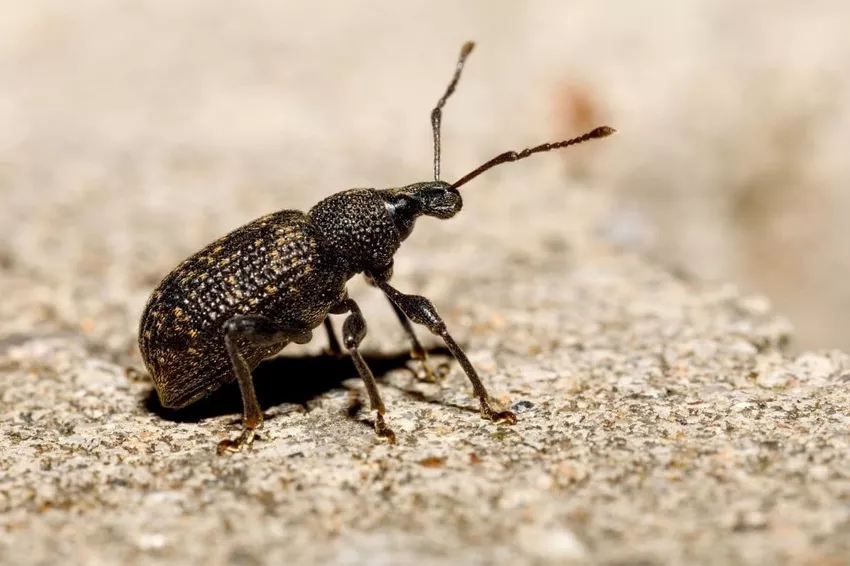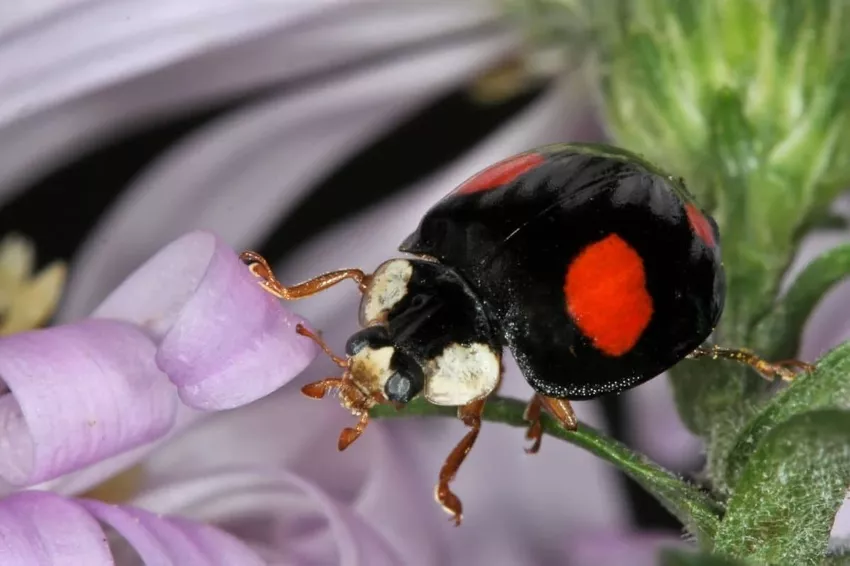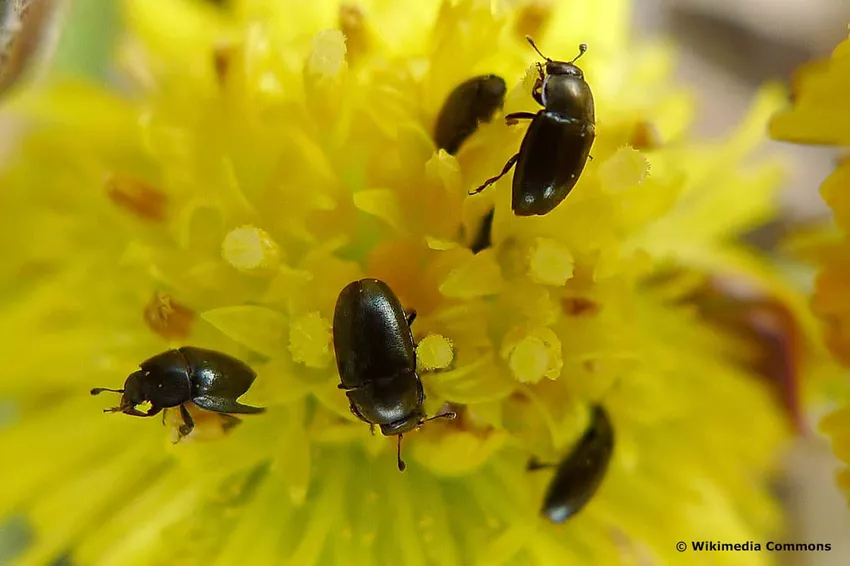
When a black winged beetle roams the garden or house, the question arises as to whether it is a pest. The experts have the answers.
In a nutshell
- black beetles always have wings, but not all can fly
- are mainly pests that need to be controlled
- different species of beetles that reside either in buildings or in nature
Black bugs in the house
The following black winged bugs are usually found in buildings.
Types from A - L
House Longhorn (Hylotrupes bajulus)

- Size: eight to 26 millimeters
- Body shape: slender, elongated oval
- Wings: with two pairs of white dots
- Airworthy
- Preferred locations: in the wood, behind wooden furniture, under wooden floors, in the attic
- special features: long antennae, legs and antennae lighter than body, heaps of wood flour on the bottom
- Remarks: rapid control is required because it is highly damaging to wood
Grain weevil (Sitophilus granarius)
 Source: CSIRO, CSIRO ScienceImage 143 A Grain Pest Sitophilus granarius, edited from Plantopedia, CC BY 3.0
Source: CSIRO, CSIRO ScienceImage 143 A Grain Pest Sitophilus granarius, edited from Plantopedia, CC BY 3.0
- Size: two to four millimeters
- Body shape: elongated, slightly flattened
- Colour: Maroon or dark brown to black with age when young
- Wings: Elytra same length as pronotum, fused together
- unable to fly
- Preferred locations: in grain foods, especially in flour, in storage rooms and cupboards, dried vegetables
- special features: active all year round, prominent grooves and bright spots on the body and trunk
- Comment: Food pest - needs control
Types of M - Z
Meal Beetle (Tenebrio molitor)

- Size: ten to eighteen millimeters
- Body shape: elongated, strongly flattened
- Colour: black beetle with red-brown legs
- longitudinally grooved, curved, black elytra, bacon-like shine
- airworthy
- Preferred locations: on starchy foods, in storage rooms and cupboards, especially in bakeries, loves flour and baked goods
- special features: active all year round in heated rooms
- Remarks: storage pest that is a health hazard - prompt control is required
Fur beetle (Attagenus pellio)
 Source: David Short from Windsor, UK, Attagenus pellio (21507687363), edited by Plantopedia, CC BY 2.0
Source: David Short from Windsor, UK, Attagenus pellio (21507687363), edited by Plantopedia, CC BY 2.0
- Size: 3.5 to six millimeters
- Body shape: elongated, oval, slender
- Colour: brown-black to black
- bright spots on wings
- very good flight ability
- Preferred locations: textiles, especially furs, larvae also in plant products
- special features: bristle tail with longer hair, adult beetles are attracted to the light
- Note: Material pest, especially larvae are very voracious - combating advisable
Black bacon beetle (Dermestes ater)
- Size: seven to nine millimeters
- Body shape: twice as long as wide
- Colour: brown-black to black, dark hair
- Half of the elytra brownish with six small black spots
- airworthy
- Preferred locations: at animal food sources such as hides, skins, dried fish and meat, dried animal food, hiding in dark cracks
- special characteristics: is attracted to the house by light
- Note: not very common, but a material pest that is feared
Black beetle outside
If a black beetle with wings is discovered outdoors, it is usually one of the following species, which only rarely stray into the house.
Types from A - L
Vine weevil (Otiorhynchus sulcatus)
 Vine weevil (Otiorhynchus sulcatus), black beetle with wings
Vine weevil (Otiorhynchus sulcatus), black beetle with wings
- Size: eight to 13 millimeters
- Body shape: oblong, oval
- Colour: dark gray to black
- Elytra armor-like, with light yellow scale hair
- unfit to fly
- preferred locations: on herbaceous and woody plants, especially on rhododendrons and hydrangeas
- special features: nocturnal, has a remarkably strong trunk
- Note: are active from April to October - plant pest - combating is highly recommended
Harlequin Ladybird (Harmonia axyridis)

- Size: six to eight millimeters
- Body: oval, rounded, broader than long
- Colour: actually orange to dark red with numerous black spots, but is often perceived as a black beetle with red spots
- Wings: transparent black, protected by elytra
- airworthy and diurnal
- preferred locations: on sunny walls and facades, on plants, in gardens and parks
- special features: M-marking on the forehead, emits stinky secretion in case of danger
- Comment: useful insect - ideal for combating plant lice
Notice: If a black ladybird is discovered in the cool, early morning, it is very likely a harlequin because it has a higher body temperature and therefore becomes active long before other ladybird species, despite the coolness of the morning.
July beetle (Anomala dubia)
 Source: Siga, Anomala dubia on finger, edited by Plantopedia, CC BY-SA 3.0
Source: Siga, Anomala dubia on finger, edited by Plantopedia, CC BY-SA 3.0
- Size: twelve to 15 millimeters
- Body: plump, stocky shape, hairless, resembles cockchafers
- Colour: blue-black, shiny metallic surface
- Wings: black, transparent, coverts medium brown to dark brown
- airworthy
- Preferred locations: sandy areas, likes on young pines and birches, in willow bushes, on blackberry bushes
- special features: pronotum widening towards the back
- Remark: usually fly around in the evening from July, are useful insects
Species with M
Dung Beetles (Geotrupidae)

- Size: 10 to 45 millimeters depending on the species
- Body: oval, slightly arched
- Colour: Depending on the species, brown-black to deep black, usually with a gold or blue metallic shimmer
- Wings: black
- airworthy but cumbersome
- diurnal and nocturnal, lively flying around especially in the twilight
- favorite habitats: forests, pastures and fields where droppings and carrion can be found
- special features: dig underground tunnels in the ground for reproduction, also suck tree sap
- Note: Bodies are mostly inhabited by countless parasitic mites, which also resettle on other animals (pets), pose a hygienic problem, combating them is urgently recommended
Notice: The dung beetle is easily distinguished from the bluebottle, also known as the dung fly. It makes the wing construction. In addition to the wings, the beetle also raises the elytra, which the dung fly lacks.
Mold beetle, black (Ocypus olens)
 Source: Daniel Ullrich, Threedots, Ocypus spec, edited from Plantopedia, CC BY-SA 3.0
Source: Daniel Ullrich, Threedots, Ocypus spec, edited from Plantopedia, CC BY-SA 3.0
- Size: one to 2.5 mm
- Body: elongate, densely structured in a point-like manner, fine, light skin on the posterior
- Colour: matt black, black hair
- able to fly, short wings
- mostly nocturnal
- preferred places of residence: mainly in damp forests and gardens, under dead wood and stones
- special features: thorns on outer front legs, raises abdomen when threatened, secretes foul-smelling secretion
- Note: not to be confused with the flightless and smaller dark predatory beetle (Ocypus tenebricosus), can bite hard, expulsion recommended
Types from N - Z
Timber bark beetle (Xyleborus germanus)
- Size: eight to 13 millimeters
- Body shape: cylindrical
- Colour: black to black-brown, often with a violet shimmer, last section of leg and antennae orange
- Elytra armor-like, twice as long as pronotum
- conditionally airworthy (only females)
- preferred locations: on coniferous and deciduous trees
- special features: nocturnal, has a remarkably strong trunk
- Note: it is imperative that you combat it quickly, as it can destroy the plants across the board
rape pollen beetle (Meligethes aeneus)
 Source: gailhampshire from Cradley, Malvern, U.K., Most probably Meligethes aeneus. Nitidulidae - Flickr - gailhampshire, edited from Plantopedia, CC BY 2.0
Source: gailhampshire from Cradley, Malvern, U.K., Most probably Meligethes aeneus. Nitidulidae - Flickr - gailhampshire, edited from Plantopedia, CC BY 2.0
- Size: one to 2.5 mm
- Body shape: oval
- Colour: black, blue-green and metallic shiny back area, black-brown head
- flies well and far
- Preferred places to stay: mainly rapeseed fields, but also other yellow-flowering plants in the garden
- special features: only looking for flowers from 15 degrees Celsius
- Comment: Plant pest - if only yellow buds on plants turn yellow and dry up, a pollen beetle can be to blame
Two-spot ladybird (Adalia bipunctata)
 Source: Holger Gröschl, Zweipunkt (Adalia bipunctata), edited by Plantopedia, CC BY-SA 2.0
Source: Holger Gröschl, Zweipunkt (Adalia bipunctata), edited by Plantopedia, CC BY-SA 2.0
- Size: 3.5 to 5.5 mm
- Body shape: rounded-oval, broader than long
- Colour: black beetle with two red dots on each side
- Wings: Translucent black under dotted elytra
- airworthy
- diurnal
- preferred locations: gardens and forests, on deciduous plants
- special features: white eye rims
- Note: natural predator of numerous plant pests, therefore no killing - hibernates in houses in a cool place, can also have yellow or orange spots
frequently asked Questions
Are there dung beetles that cannot fly?No, all have more or less the ability to fly. However, due to their relatively high weight in relation to their flying power, flying is so restricted, especially in "stronger" winds, that they can hardly or not fly at all.
Does a black free-range beetle never fly into living quarters?Yes, that can happen. Dung beetles in particular are drawn into the house if, for example, your dog's droppings remain undiscovered for a long time or a dead rat is rotting in the attic or in the basement. The black ladybird species mentioned here also sometimes get lost in the house in summer. In winter they look for a sheltered place to hibernate indoors.
Why is it not always possible to see whether a black beetle has wings?Black bugs always have wings. However, these are usually "hidden" under the so-called elytra. To use them to fly, lift them up first. This distinguishes beetles from most fly species. But despite the presence of wings, this does not mean that a black beetle is automatically airworthy.